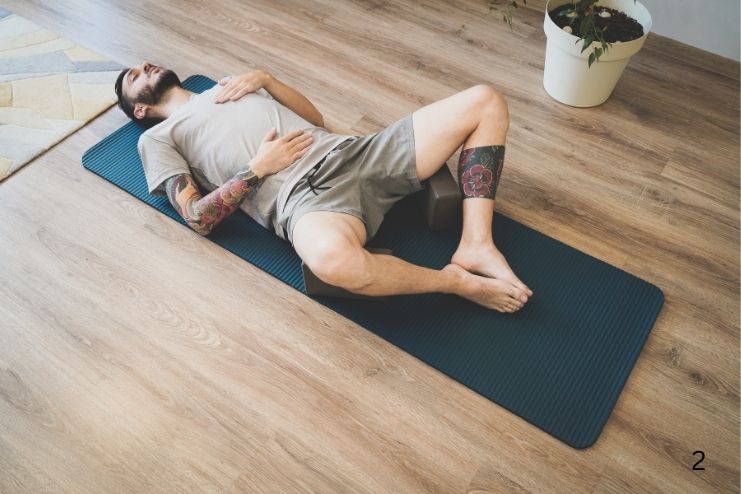Chronic asthma impairs the airways, making breathing difficult and sometimes even making it difficult to live a free life. Reaching for an inhaler has become a regular habit for many people. But what if breathing could be made easier naturally, without needing medications? Natural asthma remedies can help.
As a mild yet efficient method of managing asthma symptoms, asthma breathing exercises are becoming increasingly popular. These methods enhance lung function, relax the nervous system, and naturally lower inflammation.
They can be an excellent addition to your prescription treatment, giving you back control of your asthma without the need for medication. This article outlines seven tried-and-true breathing techniques to help you combat your asthma, regain your composure, and breathe more organically.
Read More: Breathing Exercises for Relaxation
Why Breathing Exercises Help Asthma
Breathlessness, wheezing, and a tightness in the chest are asthma symptoms, which cause the airways to become irritated, constricted, and hypersensitive. The body suffers from decreased oxygen intake and elevated stress during an attack. Breathing techniques are a potent, scientifically supported strategy in this situation. Breathing exercises function as follows:
Strengthen the Respiratory Muscles: Breathing exercises aid in the development of stronger diaphragms and other breathing-related muscles. It can expand lung capacity and enhance breathing efficiency.
Boost Breathing Control: People with asthma can learn to regulate their breathing patterns by frequently performing breathing exercises. As a result, asthma attacks may become less frequent and less severe.
Clear Airways: Certain breathing techniques, such as puffing or controlled coughing, might assist in removing extra mucus from the airways. It can lower the risk of infection, congestion, and inflammation.
Symptoms of Asthma
Symptoms play a crucial role in a health book. Symptoms are one way to determine the severity of a health issue. Asthma can be caught with some symptoms that are easily detected at an earlier stage.
- Chest tightness
- Breathing difficulty
- Coughing and wheezing
- Wheezing sound while breathing out
- Fasten breath
Read More: Nasal Breathing vs. Mouth Breathing: Which Is Better for Your Health?
Causes of Asthma
The reason why some people develop asthma and others do not is unknown to researchers. However, several factors carry a larger risk:
Family History: The likelihood of developing asthma is three to six times higher if you have an asthmatic parent than if you do not.
Allergies: Having allergies might increase the risk of asthma.
Viral Respiratory Infections: Wheezing may be a symptom of respiratory issues in infancy and youth. Chronic asthma develops in some kids when they get viral respiratory infections.
Smoking: The smoke from cigarettes irritates the airways. Smokers are more likely to get asthma. Asthma is more common in people who were exposed to secondhand smoke or whose mothers smoked while they were pregnant.
Air pollution: Exposure to ozone, the primary component of smog, increases asthma risk. Asthma is more common among people raised or residing in urban regions.
Breathing Exercise for Asthma- How does it work?
Medications such as beta-agonists and inhaled corticosteroids widen the airways to help people with asthma breathe more easily. However, these drugs might not be sufficient to manage symptoms in people with severe asthma. Breathing exercises and certain methods can improve lung health, strength, and capacity while reducing your asthma symptoms.
Consult with your physician, asthma educator, or your asthma coach before starting any new exercise. Medical professionals can make sure the breathing exercise for asthma fits your needs and circumstances.
1. Diaphragmatic Breathing:

The diaphragm is a dome-shaped muscle at the base of the chest, which separates the chest from the belly. People who practice diaphragmatic breathing will learn to breathe from the area surrounding the diaphragm instead of the chest. This method slows breathing, lowers the body’s oxygen requirements, and strengthens the diaphragm.
Steps to do:
- Look for a peaceful, comfortable spot to lie down or sit.
- Your one hand should be on the stomach and the other on the chest.
- Inhale deeply and slowly through your nose. Allow your tummy to rise as you fill your lungs.
- Breathe out slowly through your mouth. Let air out of your lungs and let your tummy drop.
- Keep taking deep breaths in and out. Pay attention to how your stomach moves and how your breath feels.
Read More: Top 10 Breathing Support Products to Enhance Lung Health Naturally
2. Buteyko Breathing:

Expanding the airways and improving blood circulation are two benefits of Buteyko breathing. This method teaches the person how to breathe more deeply and slowly through various exercises. Buteyko may reduce the need for prescription drugs and ease asthma symptoms.
Steps to do:
- Hold your breath after letting it out slowly.
- Plug the nostril with thumb and your index finger.
- Hold that breath until you need to breathe, then take a breath.
- For at least ten seconds, breathe properly.
- Do this multiple times.
3. The Papworth Method:

The Papworth breathing exercise consists of a series of diaphragmatic breathing exercises and relaxation activities. Focusing on nasal breathing teaches people which breathing muscles to employ and how to prevent breathing too quickly or deeply.
Steps to do:
- Seek out a quiet and comfortable place to sit.
- Give the body and the mind time to relax.
- Place one hand on your chest and the other on your abdomen.
- Breathe deep and very slowly through the nose, let the chest remain motionless, and the abdomen rise.
- Let the belly drop as you exhale.
- Before each inhalation (breathing in), concentrate on fully exhaling.
- Try breathing out for a more extended period. Try to exhale more slowly than inhale.
Read More: Box Breathing Technique – A Beneficial Requisite For Stress Management
4. Pursed Lip Breathing:

One way to deal with dyspnea is to practice pursed lip breathing. By slowing down breathing, this method makes sure that every breath is effective. It also helps transfer carbon dioxide out of the lungs and oxygen into them, keeping the airways open longer.
Steps to do:
- Choose a comfortable sitting position, such as on the bed or in a chair.
- Drop your shoulders and place one hand on your stomach and the other on your chest.
- Take a deep, leisurely breath through your nose. As you inhale, feel your tummy grow. Hold the hand on your chest as still as you can.
- Pucker your lips, as if you were whistling or blowing out a light. Slowly exhale through pursed lips.
- Continue inhaling through the nostrils and exhaling via your pursed lips for many breaths.
5. Nose Breathing:

Unlike mouth breathing, which is associated with severe asthma symptoms, nose breathing is an excellent breathing exercise for asthma patients. Before air enters the lungs, it can be filtered, warmed, and humidified via nose or nasal breathing, which is used in several breathing exercises.
Steps to do:
- Take a comfortable seat with your legs crossed.
- Using your right hand, grasp the right knee.
- Lift your left hand and move it closer to your nose.
- Completely exhale, then seal the left nostril with your left thumb and other fingers.
- Using your thumb and fingers, shut your right nostril after taking a big breath.
- Exhale from your left nostril.
- Breathe deeply through your left nostril before closing it.
- Exhale through your right nostril.
- Continue this cycle for approximately five minutes.
Read More: 12 Breathing Techniques For Sleep To Drive Insomnia Away
6. Yoga:

Breathing exercises like pranayama or yoga may help certain asthmatic patients. These activities can improve asthma symptoms, oxygenation, lung function, and the frequency and intensity of asthma attacks.
Cobra Pose: Another beneficial exercise for those with asthma is cobra pose, sometimes called Bhujangasana. The cobra stance improves the body’s ability to circulate blood and oxygen. Additionally, it relieves asthma symptoms by opening up the chest and clearing the passageway to your lungs.
Bridge Pose: Bend your knees while resting on your side with your feet wide at the hips and level on the floor. Then, raise your hips, place your feet and hands on the ground, and join your hands behind your back. This stance encourages better airflow, expands the chest, and aids lung expansion.
Sitting Mountain Pose: Sit comfortably with your legs crossed. Raise your arms overhead, close your eyes, keep your spine tall, and focus on your breath. This pose can help relieve stress and anxiety, common triggers for asthma.
Fish Pose: While lying on your back, place your hands beneath your hips. Raise your chest slowly, then tilt your head back so that the top of it rests on the mat. The fish posture increases airflow and opens the lungs.
Plan for Managing Asthma
Recognize your Asthma Triggers and Avoid them as much as possible: The most excellent strategy to lessen your medication needs and avoid asthma attacks is to stay away from your triggers. However, you must first identify those triggers. Whenever you experience an asthma attack, consider your location and activities during the previous day or so.
As directed, take your Asthma Medications. The three most common ways to breathe asthma medications are through a nebulizer, a metered-dose inhaler (also known as an inhaler, puffer, or MDI), or a dry powder inhaler (DPI). Inhalers need to be used appropriately to function properly. However, almost 50% of inhaler users do not use them correctly. Request a technique check from your physician or nurse.
Monitor your Asthma and Look for Early Symptoms: Asthma attacks rarely happen suddenly. Early symptoms that some people experience include coughing, heaviness in the chest, and/or fatigue. However, remember that you might not have symptoms until your airways are severely clogged because the lungs’ airways narrow gradually. Taking your medication as soon as your asthma symptoms start to worsen is crucial to managing your condition.
Read More: 10 Common Triggers That Could Worsen Your Asthma
Conclusion
Even though asthma is a chronic illness, you may be surprised at how effective natural asthma management can be. By regularly practicing these breathing techniques, you can increase your oxygen intake, soothe irritated airways, and regain control of your asthma without relying entirely on medicine. These straightforward yet effective methods provide genuine natural asthma relief, enabling you to breathe more easily, move more freely, and live more assuredly.
Keep in mind that growth is made one breath at a time. These natural remedies for asthma can have a long-lasting effect on your everyday life, regardless of where you are in your wellness path. Are you prepared to advance in your quest for improved breathing?
-
Mar 2019Written by Ramya
-
May 2025Edited by Ankita
References
- https://www.uclahealth.org/news/article/how-use-breathing-exercises-improve-asthma
- https://allergyasthmanetwork.org/news/breathing-exercises-for-asthma/
- https://pmc.ncbi.nlm.nih.gov/articles/PMC7096190/
- https://neaai.com/asthma/breathing-exercises/
- https://healthwire.pk/healthcare/breathing-exercises-for-asthma/
- https://www.mayoclinic.org/diseases-conditions/asthma/symptoms-causes/syc-20369653
- https://aafa.org/asthma/asthma-symptoms/
- https://www.lung.org/lung-health-diseases/lung-disease-lookup/asthma/learn-about-asthma/what-causes-asthma
- https://my.clevelandclinic.org/health/diseases/6424-asthma
- https://aafa.org/asthma/asthma-prevention/
In this Article

















